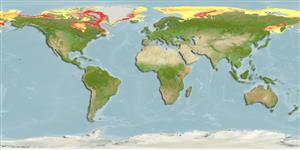Environment: milieu / climate zone / depth range / distribution range
Ökologie
seewasser demersal; tiefenbereich 5 - 1038 m (Ref. 117245). Polar; 84°N - 50°N, 180°W - 180°E (Ref. 117245)
Arctic to Northwest Atlantic and Northwest Pacific: Canadian Arctic to Hudson Bay, Ungava Bay and Labrador in Canada (Ref. 7251). Arctic Ocean, Barents Sea, Franz Josef Land, Spitsbergen, eastern Greenland, Kara, Laptev, Siberian and Chukchi seas and the Sea of Okhotsk.
Size / Gewicht / Alter
Maturity: Lm ? range ? - ? cm
Max length : 10.0 cm SL Männchen/unbestimmt; (Ref. 4701)
Rückenflossenstacheln (insgesamt): 7; Rückenflossenweichstrahlen (insgesamt): 11-13. Caudal fin rounded. Dorsal fin spines not visible (Ref. 4379). Olive, darker dorsally (Ref. 4379).
Found on mud, gravel or stone bottoms at temperatures below 0° C (Ref. 4701). Young occur in shallower water (Ref. 4701). Benthic; feed on crustaceans and oikopleura (Ref. 58426).
Life cycle and mating behavior
Geschlechtsreife | Fortpflanzung | Ablaichen | Eier | Fecundity | Larven
Stein, D.L., 1986. Cyclopteridae. p. 1269-1274. In P.J.P. Whitehead, M.-L. Bauchot, J.-C. Hureau, J. Nielsen and E. Tortonese (eds.) Fishes of the North-eastern Atlantic and the Mediterranean. UNESCO, Paris. Vol. III. (Ref. 4701)
IUCN Rote Liste Status (Ref. 130435)
Bedrohung für Menschen
Harmless
Nutzung durch Menschen
Mehr Information
NamenSynonymeMetabolismusRäuberÖkotoxikologieFortpflanzungGeschlechtsreifeAblaichenSpawning aggregationFecundityEierEientwicklung
ReferenzenAquakulturAquakultur ProfilZuchtlinienGenetikElectrophoresesVererbbarkeitKrankheitenVerarbeitungNutrientsMass conversion
PartnerBilderStamps, Coins Misc.LauteCiguateraGeschwindigkeitSchwimmstilKiemenoberflächeOtolithsGehirngrößeSehfähigkeit
Tools
Zusatzinformationen
Download XML
Internet Quellen
Estimates based on models
Preferred temperature (Ref.
123201): -1.2 - 2.9, mean 0.2 °C (based on 2662 cells).
Phylogenetic diversity index (Ref.
82804): PD
50 = 0.5000 [Uniqueness, from 0.5 = low to 2.0 = high].
Bayesian length-weight: a=0.02089 (0.00774 - 0.05639), b=3.03 (2.79 - 3.27), in cm total length, based on LWR estimates for this (Sub)family-body shape (Ref.
93245).
Trophic level (Ref.
69278): 3.3 ±0.34 se; based on food items.
Widerstandsfähigkeit (Ref.
120179): mittel, Verdopplung der Population dauert 1,4 - 4,4 Jahre. (Fecundity assumed < 1000).
Fishing Vulnerability (Ref.
59153): Low vulnerability (10 of 100).
